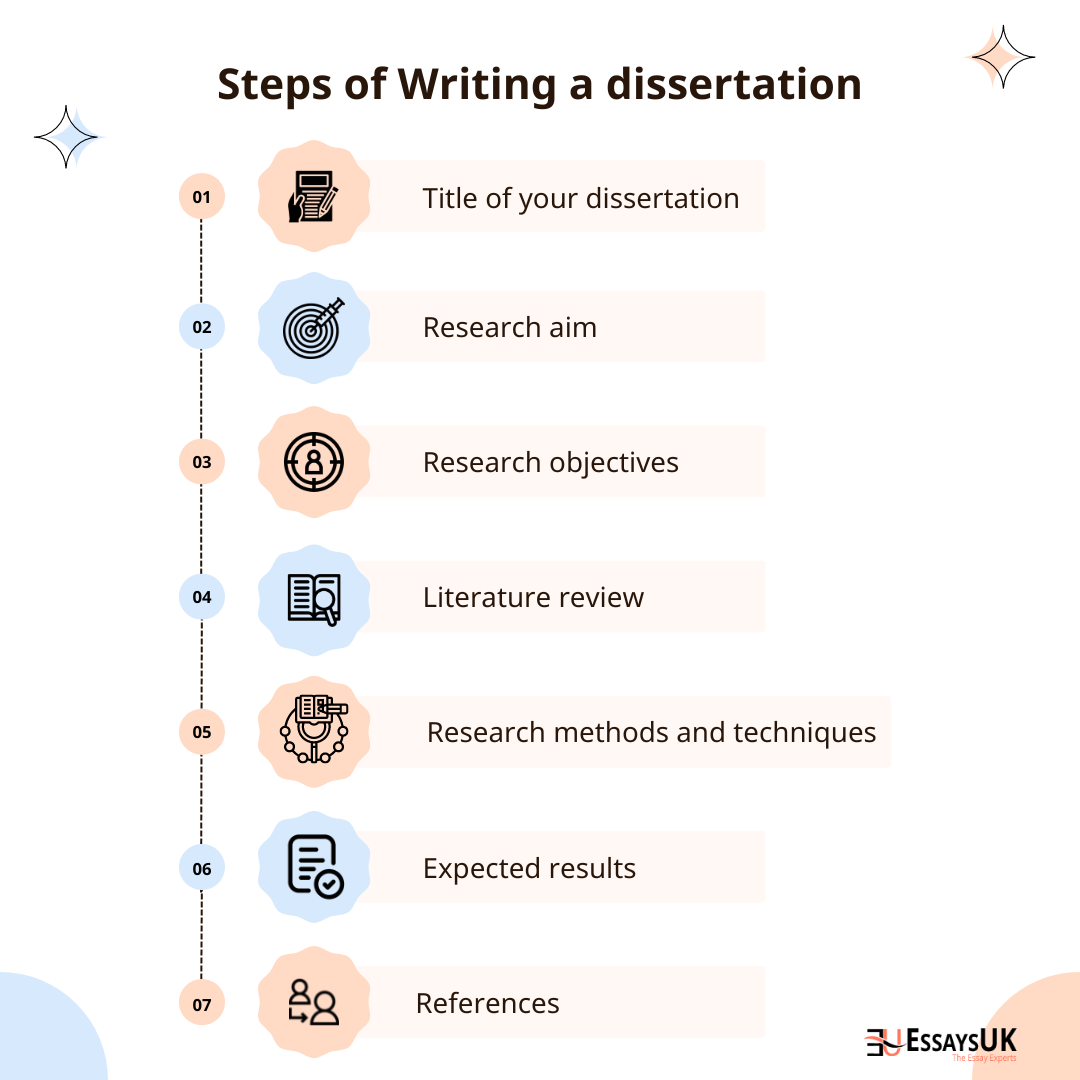How to Write a Dissertation? – Complete Guide
A dissertation is a type of academic writing that is lengthy and based on thorough and original research. It is an essential part of your master’s and PHD degrees; for some, it is also helpful in undergraduate studies.
Due to its complexity, many students need help figuring out how to write a high-quality dissertation. Here, you will be provided with the help required to write a complete and impeccable dissertation through a step-by-step guide on how to write a dissertation. It is perfect for beginners and researchers who have already submitted their proposals. This guide also talks about the structure of a dissertation.
How to Structure a Dissertation?
The structure of a dissertation usually depends on your university, the subject, and the level of education, but it commonly consists of four to five chapters and a few compulsory pages. This article describes the standard method of how to write a dissertation.
Title Page
Every dissertation begins with a title page containing the topic of your dissertation, your name, institution, and degree. However, the title page differs in some formats. For instance, some might also include your university’s logo, student ID, and supervisor’s name. Consult with your faculty to find the apt format for your dissertation.
Complete guide: Dissertation & Thesis Acknowledgements
Acknowledgements
In the acknowledgements section, you can express gratitude to the people who have supported or helped you in your research. Generally, researchers appreciate the following:
- Supervisors or the committee of their dissertation,
- Advisors or mentors who have helped them with some topics,
- Their family includes parents, spouses, siblings, etc.
Keep your acknowledgement concise and complete (for example, XYZ, for their tolerance and attentiveness). The length should be one page at maximum.
Abstract
An abstract is a summary, mostly 200 to 300 words, describing your dissertation. It mainly introduces your dissertation to the audience, which makes it one of the most crucial components of your dissertation. Your abstract must be captivating enough to attract the audience to investigate more about your dissertation topic. You should write this part after you have completed your dissertation because it should include
- The main topic,
- Objectives of the dissertation,
- Research methods used,
- Results summary,
- And a quick conclusion.
Table of Contents
The table of contents makes navigation easier for readers. You should write the titles, the subtitles and their corresponding page numbers along with them. It is easy to make a table of contents on Microsoft Word as it lets you create one automatically if you use heading styles. You can also just click on a specific heading and instantly go to the particular part of the document.
List of Figures and Tables
Let’s first discuss the difference between a figure and a table. A table is a visual element with rows and columns, while a figure consists of related images and diagrams. A list of figures and tables is a compilation of all the figures and tables in the document. It also has page numbers for easy navigation.
List of Abbreviations
An abbreviation is a short form of a word or phrase. For example, NASA is the abbreviation of the National Aeronautics and Space Administration. A list of abbreviations includes all the abbreviations in alphabetical order used in your dissertation.
Complete reference guide: Abbreviations List – Rules, Recommended Template & Example
Glossary
This is like a dictionary. You include all the difficult words that the reader might not know or the audience is unfamiliar with in alphabetical order.
Complete guide to understand: What is a Glossary in a Dissertation or Thesis? – Guide With Template
Looking for experts?
We are here to help!
- Topic Suggestions
- Confidentiality
- 100% Plagiarism Free
- Qualified Writers
- Low Prices
- Proofreading

This is the official start of your dissertation. It carries the abstract and should be attractive enough that the reader is immediately bewitched by it. It is a guideline of what the reader can expect from the rest of the dissertation. It mainly includes
- The scope of the research
- The focus of your study
- The primary research question
- Goals and objectives of the research
The introduction should also be written at the end before the abstract. However, make sure to write a rough draft of the introduction before you start writing the rest of the dissertation.
Literature Review
A literature review gives an understanding of the topic concerning already existing work in the field. It not only provides the summary of previous literature but is the basis of justification of the current researcher.
A literature review mainly talks about the gaps in the previous research, new methodologies in the paper, and a better solution to the problems. Here’s a step-by-step guide on how to write a literature review for your dissertation.
- Collect the relevant data and research papers from authentic sources such as journals, Google Scholar etc.
- Evaluate the sources, their accuracy, authority, relevancy, and currency.
- Analyse the sources by demonstrating the elements in the history of the source.
- Draw connections through gap analysis etc.
Instead of just summarising previous research in the dissertation literature review chapter or section, construct a logical structure and line of reasoning that establishes a strong foundation for your dissertation.
Methodology
This part of the dissertation talks about how you conducted the research and came up with the results. It also shows that your method is pragmatic and can be used in future research. The methodology discusses the following elements:
- The approach used to conduct the research
- How what, and when of the dissertation
- Methods to analyse data
- Obstacles faced while conducting the research
- The tools and materials used
- A justification for your method.
To avoid writing lengthy reports, take into account how much information you need to share. You probably don’t need to provide much background information or rationale if you are employing approaches that are standard in your discipline.
Results
Before writing the results section, go through the objectives and primary research question of your dissertation. The results contain the findings and statistical data of your research. It describes what your methodology has discovered. You should only write the relevant results.
The question might come to your mind about how to understand which information is important. This is where going back to the main research question helps. Ask yourself, which data answers my research question? There, that’s the important data.
You can add tables, charts, and other visual elements to make your results stand out. In some research papers, the results section is a part of the discussion, while in others, it is written separately. This part also includes the problems encountered while carrying out the research, e.g. unavailability of data etc.
Discussion
The discussion section helps to explore the meaning of your findings which is discussed according to the research question. It includes what the results mean, why the results matter and the constraints associated with the results. While the results section contains the statistical data, here, you talk about the interpretation and explanation of that data.
Three things are added in the discussion chapter.
- Analysis of data
- Exploration of the meaning of data
- Identifying the importance of data
Conclusion
In some formats, the conclusion is brief, while in others, the conclusion is considered to be the final chapter of your dissertation, making it extremely important. This section is a bit similar to the discussion one as it discusses the critical findings of the research.
The conclusion precisely answers the primary research question. It reports the main research outcomes and mirrors them with the objectives. It should leave the audience clear of your main argument. Moreover, it includes future work and concluding remarks.
Reference List
Choose one citation format and follow it to cite the relevant sources for consistency. The Harvard and Vancouver referencing styles are most commonly used in the UK. The most popular citation styles used are
- MLA,
- APA,
- and Chicago.
Giving credit to the researchers whose work you are using is crucial in the dissertation to avoid plagiarism.
Appendices
While your dissertation only includes the essential aspects of the research, you can add the questionnaires, transcripts, and other relevant materials in the appendices.
Now that you know how to write a dissertation, here are a few tips to follow to improve your dissertation.
Follow the given dissertation writing tips and start working on your research!
- Plan a schedule
The hardest part of writing a dissertation is time management. Many students leave their work for the end and are later overwhelmed by the amount of work. Make sure to plan a realistic schedule and follow that schedule to ensure better results. - Keep a record of your sources.
You have to keep a full record of your sources. You have to put references in your dissertations, and it would save a lot of time if you kept a record of the sources to cite later text well. - Get early feedback.
If your supervisor is flexible and helpful, you should always check in with them before writing the next part. This way, they can alert your problems sooner. - Take care of yourself.
This is the most important part while doing anything. Your mental and physical health comes first and should not be compromised. Take small breaks from working on the dissertation.
Frequently Asked Questions
First, you will tell us your requirements, and we will set a budget. Then we will assign the relevant writer to you. The writer will rigorously work on your dissertation and deliver the text on time. We only confirm the content once the customer is 100% satisfied.
The structure of a dissertation depends on the subject and level of study. The standard format includes the following titles:
- Introduction
- Literature Review
- Methodology
- Results
- Discussion
- Conclusion
We are glad that you asked. We can cite in any format your university has asked you to. The common citation formats we use are MLA, APA and Chicago.
EssaysUK has done various projects, and the testimonials are attached to the page. We have 100%, satisfied customers. It is a trustworthy custom writing business that adheres to stringent rules and regulations. EssaysUK offer written documents that can be utilised as examples, references, or research materials, depending on your requirements.
EssaysUK ensures the least plagiarism by writing unique and original papers. If work from other sites is taken, they are mentioned. Moreover, all dissertations go through a proofreading method where plagiarism is checked, and any excessive duplication is instantly removed. Also, once we have delivered your work, we do not use it in future work.
You must complete the form with all the necessary order-related information to place an order on our platform. Place your deposit. After which, we will pay the amount to the author if you are happy with their work. You may always contact our customer service department if you have any questions.




